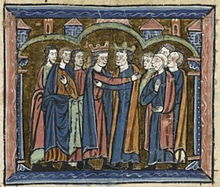Battle of Fréteval
The Battle of Fréteval, which took place on 3 July 1194, was a medieval battle, part of the ongoing fighting between Richard the Lionheart and Philip II of France that lasted from 1193 to Richard's death in April 1199. During the battle, the Anglo-Norman and Angevin forces ambushed the French army, which was defeated. Philip managed to flee but lost his archives which were captured by Richard. After the battle, Philip decided to keep them in Paris, which led to the creation of the French national library, the Archives Nationales.[1]
Background

Encounter at Fréteval Wood
King Philip probably shadowed Richard's army, as the latter moved through the
One of the reasons kings of the period were so often adverse to pitched battles was the fact that they travelled as an itinerant government and nomadic treasury, which were too valuable to lose on the battlefield.[10] And since kings of this period often travelled as peripatetic courts, Philip's baggage train contained not just personal effects, such as household furniture[11] but the necessary paraphernalia for government and tax collecting.[12] Among the French king's luggage, captured by the English, were his personal seal,[13] and important archival documents such as financial records, domanial charters, payment inventories, and rent and toll receipts.[5][14] Also captured was a great quantity of treasure, 'whose value was immense,' said one French chronicler.[15] Philip beat a hasty retreat across the River Epte, and in doing so, the bridge collapsed under the weight of the retreating army.[16] This apparently resulted in the French king getting soaked through, which one writer has described as 'a condition which delighted Richard.'[17] The English King may have come 'within minutes' of capturing Philip,[18] but, being overly-enthusiastic in his attempt to capture Philip, rode a great distance past the chapel where Philip was actually hiding, allowing him to escape.[19]
Aftermath
The archives, it has been claimed, gave Richard the names and details of all of Philip's spies and agents in the duchy of Aquitane,
Richard, although he was never to return to England, dispatched the captured French archives to London, where they were deposited in the Tower.[24] As a result of this battle, Philip became the first French king not to take his archives on campaign with him, as had been customary,[25] but to create the Trésor des Chartes in Paris for permanent deposit[26] in a newly created new Chancery.[27] This has been described as "a first step in maintaining the documentary record of monarchial government."[25]
References
- ^ "Culture 41 – Lettre F comme.... Fréteval !". culture41.fr. Retrieved 2017-07-01.
- ^ doi:10.1093/ref:odnb/23498. Archived from the original on August 27, 2017. Retrieved August 27, 2017. (Subscription or UK public library membershiprequired.)
- ^ ]
- ^ ISBN 978-0-520-91111-6.
- ^ JSTOR 1867650.
- ISBN 978-1-317-89903-7.
- ^ ISBN 978-0-300-09404-6.
- ISBN 978-0-300-09404-6.
- ISBN 978-1-317-89903-7.
- ISBN 978-0-275-99397-9.
- ISBN 978-0-520-91111-6.
- ISBN 978-0-520-91111-6.
- ^ Thomas Frederick Tout; Hilda Johnstone; Margaret Sharp (1920). Chapters in the Administrative History of Mediaeval England: The Wardrobe, the Chamber and the Small Seals. Manchester University Press. pp. 147–. GGKEY:Y2RJRNEEQW1.
- ISBN 978-1-78022-443-5.
- ISBN 978-0-520-91111-6.
- ISBN 978-0-520-91111-6.
- ISBN 978-0-14-016664-4.
- ISBN 978-0-7509-5475-4.
- ISBN 978-0-7524-7304-8.
- ^ ISBN 978-1-317-89903-7.
- ISBN 978-0-300-09404-6.
- ISBN 978-0-520-91111-6.
- ISBN 978-0-520-91111-6.
- ^ Sinnett's picture of Paris. 1845. pp. 89–.
- ^ JSTOR 25542338.
- ISBN 978-0-226-59135-3.
- ISBN 978-0-8240-4444-2.
